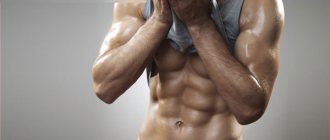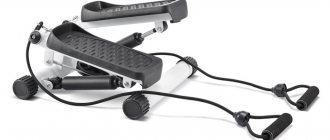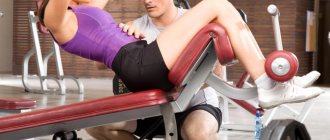Hello, dear friends! Today the topic under consideration is “Which muscles work on which simulators?”
The topic is pressing. Before going directly to the hall, we need to understand what we will see there and what to do with this magnificence. Beginners, and often regulars, sometimes don’t know how to diversify their classes with new exercises. And not everyone has time to share their knowledge about the functionality of simulators.
I suggest you take a kind of “Young Fighter Course.” Are you ready? Go! To begin, outline for yourself a rough training plan that you will always follow. Include a warm-up, main part, and cool-down. Warm-up and cool-down should take at least 20 minutes. Such rules were invented in order to adjust the body to a different environment. Time management rules are important to follow to obtain results and prevent injuries.
Types of simulators
Let's consider all types of simulators on which we will train.
What types of simulators are there:
- Cardio machines.
- Strength training equipment.
- Block simulators.
If the question arises - “What kind of exercise machine will help you get rid of your belly and sides?”, then any correctly chosen trainer will confidently point you to the cardio room, because that’s where the most effective exercise machines for reducing volume are located.
Almost everything in the cardio zone additionally pumps the buttocks and legs. If you are more interested in what kind of exercise machine you can use to pump up your buttocks, then you should go to the “rocking room” - the weight room. Block simulators are a special article. Formally, they belong to the power category, but they are singled out because of their versatility. They contain “Bottom Blocks” (those that are attached to the bottom, and which most often need to be pulled up) and “Top Blocks” (those that are attached to the top, and they need to be pulled down). Sasha Bogrtich trained on them when she starred in the film “I’m Losing Weight.”
Characteristics of strength training equipment
Type
Fitness station
This is a multifunctional simulator that combines the functions of several separate simulators. The second name is multistation. Models with built-in and free load types, as well as combined units, are available.
The first universal type uses additional weights - disks. And the second type of combined model is a bench for working with free apparatus.
Refers to semi-professional and professional appearance. The models are designed for installation in sports and fitness rooms, saunas and health centers. The difference is that they create a constant load on the main muscle groups.
The design is stable, the material is heavy. The difference between professional models and home ones is the noise suppression function. The set does not include expanders, stops or handles.
Block frame trainer
The design is similar to a horizontal bar: two vertical blocks and an upper crossbar. There are cables with loads around the perimeter. Models with built-in load type are available. The frame is stable and designed to work deep internal muscles.
Using the device, the abs, buttocks, arms and back are trained. Intended for professional training of athletes and rapid mass gain.
Features - training the arms and chest (in a standing position, abduction and extension are performed), triceps (straightening the arms while standing in place), abs (bending forward in a kneeling position).
Allows you to train all basic muscle groups, provides point loading and a varied range of exercises.
Smith machine
This is a universal type of exercise machine with the principle of free weight. Combines basic elements to work the entire body. Used as a home station or professional equipment in the gym. The design is block, multifunctional.
The Smith machine specializes in building muscle mass in a short time. The design consists of several planks to work out all areas of the body. The emphasis is on building and correcting the muscles of the arms, back and abs.
An increase in volume occurs with hypertrophy of muscle fibers, which occurs due to intense contraction during exercise.
Strength trainer
This type is for training, strengthening and building muscles. Universal models are produced, which are discussed above, and specialized ones, designed to work on individual areas of the body.
Specialized devices are named after the area of the body that is worked on a strength simulator. They produce models for the back, abs, legs and arms.
Equipment
Bar stand
A versatile steel design, often all-metal, designed for training with equipment in the gym or at home.
The barbell rack is used for professional training; it helps adjust the load on the athlete, add or remove weights from the barbell. Sold complete with a power bench for bench press.
It is based on a frame that can support up to 200-500kg. The stability and maximum weight of the model are specified individually for different manufacturers.
Choose models with limiters built into the structure of the supports, which make the equipment safe when lifting and squeezing.
Scott's bench
A device that is used to train the biceps and brachialis. This is a bench press with a curved bar that allows you to train your arms while lifting dumbbells while lying down.
The equipment belongs to the shaping group and helps to adjust the size and shape of a specific muscle.
The design is oblong, with an upward rise at chest level and a downward curved edge for fixing the arms during the exercise.
Abdominal bench
Sports bench for working the muscles of the core, back and abdomen. There are five varieties:
- with tilt adjustment – helps to change the load during training;
- hyperextension – suitable for training the entire core;
- with a curved back - increases the load;
- Roman bench – equipped with a leg brace and a seat, increases the load;
- universal – designed for complex training.
There are five types of design - a bench with a slope and additional elements. The angle allows you to increase the load during bending. When choosing, pay attention to the athlete’s permissible weight for training.
Abdominal support
Equipment that is designed to work out the abdominal muscles under its own type of load. The design is stable; there are handrails for fixation at the level of the elbows.
The load during the exercise is given by the weight of the legs, which rise at right angles to the body. When choosing, pay attention to the lock and height of the stand.
Crunch rope
A device for working out the abdominal muscles using crunches. This is a cable with two handles at an angle, a loop or a belt for fixing on the hands. The equipment is designed to be loaded under tension.
Available complete with fitness stations, sold separately for training with an abdominal bench.
Horizontal bar
A gymnastic apparatus that is designed for universal body training. A beam structure that is mounted horizontally on two supports. It is produced as part of a fitness station or as a separate equipment for installation at home, on the street or in the gym.
Bars
A gymnastic apparatus that is designed to perform several groups of exercises. Allows you to perform both swing and power movements.
Develops strength, flexibility and endurance. This is universal equipment that is designed to perform a wide range of elements.
Stepper
Mechanical simulator for training the muscles of the lower limbs and body. It is a design with two pedals on springs, imitating race walking.
For the load, use the tension of the cable, which is attached to the hands. Trains the torso and upper limbs, works well on areas where fat deposits accumulate (buttocks, outer and inner thighs, calves). The machine is suitable for cardio training.
Twister trainer
This is a cardio machine that is used to work out the entire body, waist and hips. The design rotates along the axis; a handle-wheel is provided to fix the body. The simulator is suitable for use at home.
For training the buttocks and legs, a stepper is built into the lower structure. The equipment is used for cardio training at home or in the fitness room. Types of exercises
- Vertical row: an exercise for working the back. Helps increase muscle volume, adjust shape and size. Intended for the formation of deltoid and trapezius muscles, forearms, buttocks, biceps, abdomen and lower back.
- Horizontal row: movements that are opposed to vertical row. Designed to train the internal trapezius muscles, improve posture, align the back and spine.
The shoulder joints are also worked. Prescribed for training athletes and rehabilitation of patients.
- Lower row: designed to correct the lower body. All areas of the back are worked out, the entire body is trained. Performed in a sitting position with half-bent legs extended forward.
- Shoulder Press: An exercise to develop the muscles of the arms, shoulders and back. Performed using dumbbells in a sitting or standing position, arms raised up from the shoulder. Strength training helps to adjust volumes.
- Chest Press: An arm and chest workout done while lying down on a bench press. Strength equipment with free weights is used: dumbbells or a barbell with weights.
- Chest Row: Works the broadest muscles of the body to correct size and volume. Performed in a standing position or sitting on a bench, muscles throughout the body are involved, but the lifting is done by the arms.
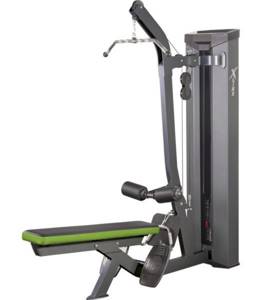
Equipment with a free type of load is used: dumbbells or a barbell with weights. Performed at a barbell rack to ensure safety.
- Butterfly: a machine exercise to train the internal muscles of the chest. The technique is reminiscent of the swimming style of the same name.
- Arm Curls: A free-load or machine-based workout that targets isolated areas of the body. Used in bodybuilding.
- Arm extension: an isolated technique that helps work the inner part of the body. Used in bodybuilding. Performed while sitting or standing on a bench.

For weighting, free weight equipment or exercise machines with built-in weights are used.
- Arm raises: an exercise for training the muscles of the chest, upper back and shoulders, to create volume and relief on the torso.
It is performed in a sitting or lying position on a bench with equipment with free weight - dumbbells or weights. An alternative is a machine with built-in weights and tension cables.
- Back extension: a type of basic exercise for working the abs, extensor muscles of the back, buttocks and hips. It is performed in a lying position on the stomach, on half-bent arms with palms facing the floor.
To perform it correctly, you need to lift your entire abdomen above the support surface.
An alternative exercise with built-in weights is performed on the machine - in a sitting position, with a handrail fixed at the level of the middle of the back, which is pushed upward when lifting.
- Pullover: A basic free weight exercise to target the latissimus dorsi and chest muscles. Performed using equipment: barbells or dumbbells.
The difference is the technique of performing stretching with a load fixed in the hands. Position – sitting and then lying with your back on a bench.
- Crunches (abs): an exercise to develop the abdominal muscles. A press bench with leg clamps is used. Instead of bending the torso, a slow twist of the stomach is performed from the chest with the arms drawn back.
- Leg raises: a technique for training the outer thighs and buttocks on a machine with built-in weights. The lower limbs are fixed in the blocks of the apparatus and moved apart under load.
The difference is an isolated exercise of the gluteus medius muscle. Leg abduction is performed on another function of the simulator, where the load falls on the inner thigh.
- Leg press: an isolated exercise for a comprehensive workout of the thighs and buttocks. It is performed on a simulator in a position lying upside down, the load must be pressed upside down. Helps correct shape and increase volume.
- Squats: Exercises performed on a machine with free or built-in weights. In the first case, these are dumbbells or a barbell with weights. In the second there is a specialized apparatus. Squats help increase the size of the muscles of the lower extremities.
- Leg Curl/Extension: An exercise to correct the lower legs, calves and lower legs. Performed on a fitness station in a lying position, understanding free or built-in weight.
Maximum person weight
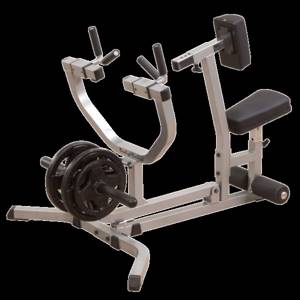
When choosing, pay attention to your own weight, adding another ten kilograms to the indicator for reserve.
- If your weight is 100 kg and you are looking to gain muscle mass, choose models with a maximum user weight in the range of 121-150 kg. These are semi-professional and professional class devices.
- ≤ 120 kg – standard for home exercise equipment. Free weight models are designed for the average person. They produce models for women and children. These are equipment with a free weight or hydraulic loading system.
- 121 – 150 kg is the average for home and fitness gyms where professional athletes train. Home and semi-professional models are available.
These are equipment with a built-in or free load type and a hydraulic system.
- > 150 kg – Models for weightlifters, rehabilitation training of people. These are semi-professional and professional equipment with free or built-in weights.
The indicator takes into account only the weight of the athlete, it does not include the weight of the equipment and body.
Maximum weight of key fobs

As a standard, the ratio is indicated in the technical data sheet of the equipment. This is an indicator of the strength of the training apparatus.
- ≤ 100 kg: these are devices for non-professional use that are purchased for home use. Suitable for users with zero experience in sports.
- 101 – 150 kg: this is an option for women who are already involved in sports and men with a body weight of less than 80 kg. Indicator of home or semi-professional equipment.
- 151 – 200 kg: professional and semi-professional level devices for heavyweight athletes, which are suitable for gaining muscle mass. Installed in gyms and fitness centers.
- > 200 kg: professional equipment for bodybuilders, athletes. Used only in professional fitness centers and gyms.
Additional options
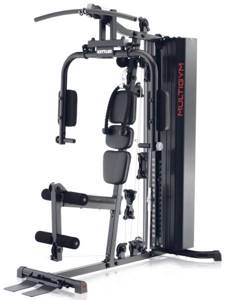
They help to adjust universal equipment to the individual characteristics of the body: height, weight, permissible load.
- Seat adjustment. Used to increase or decrease the load on the body during strength exercises.
- Back adjustment: an additional option for adjusting the angle of inclination of the device, changing which increases or decreases the load on the body. When choosing, pay attention to the regulator handle and rotation range.
- Handle height adjustment: the ability to change the height of the body, legs or other functions during exercise. Helps you adjust the device to your body.
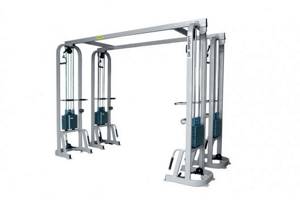
- Bottle holder: holder for an individual drink to drink during exercise. Helps replenish fluid loss in the body from excessive sweating.
- Block Cover : Covering the bench, seat, and other parts of the equipment body that come into contact with the body. Helps you exercise without damaging your skin with bruises, scratches, calluses and abrasions.
Prevents slipping when performing certain groups of exercises.
- Transport rollers: mounted on the base of the equipment frame to move heavy equipment around the hall.
So, cardio equipment, which one should you choose?

Exercise bike
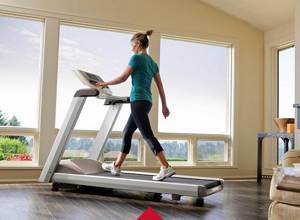
Treadmill

Ellipsoid
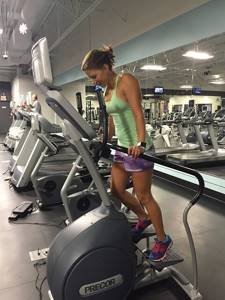
Stepper
- The bike trainer develops overall endurance, strengthens your calves and legs in general.
- The ellipse is similar to a bicycle, but is more aimed at the quadriceps (by adjusting the length of the step, you can change the emphasis of the load from the front of the thigh to the buttocks).
- The treadmill strengthens your legs and increases endurance (This is the most energy-intensive type of exercise machine, but you should use it with CAUTION: the impact load can have a bad effect on your knees, it is recommended to alternate with the ellipse).
- The stepper simulates walking up the stairs, pumping up the buttocks and quadriceps.
All cardio equipment improves endurance and helps burn calories; you can choose the one you like best for your workout. Interval loads are more effective in fat-burning training - cyclic alternation of load or speed (depending on the simulator).
The next point is which simulator trains which muscles. The list of exercise equipment and exercises by muscle group will be listed in small sections for ease of perception.
What exercise machines pump up the shoulder girdle and arms?
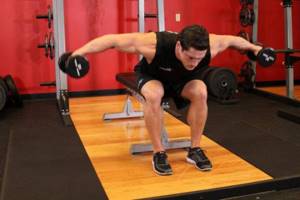
Dumbbell Raise

Lower block thrust in a crossover

Upper block thrust in a crossover
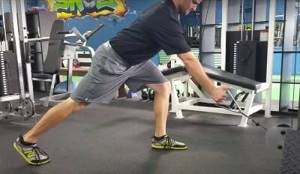
One-handed lower pulley in a crossover
For the shoulders, free weights such as dumbbells and barbells are mostly suitable.
- To work the deltoid muscles (they are located directly above the shoulder joint), exercises are used to lift dumbbells to the sides, forward, and up. These muscles are small and get tired quickly, so about 20 repetitions will be enough for you to feel the exact location of your deltoids.
- Biceps are pumped by all exercise machines associated with bending the arm. For example, lower block rows for biceps in a block machine.
- The triceps are pumped opposite, with arm extensions. The same block simulator, but we take the top block and pull it down.
- Pull the crossover lower block with one hand
What's in the hall
In most cases, any gym has several special zones for different types of load. Zoning occurs according to the following principle:
- Cardio – where cardio equipment is installed, there is a place to jump rope.
- Strength - usually takes up most of the room, includes various strength training equipment, as well as racks for working with free weights.
- CrossFit - where specific equipment for training in this area is installed, is not a mandatory area and is not present in all gyms.
- For stretching, it usually takes up a small space on which a person can lay out a mat and do a cool-down.
Each of these zones is equipped with special equipment, which can also be divided into separate categories:
- Exercise machines are mainly mechanical, but sometimes electrical, combined devices that help to specifically influence an individual muscle, a group of muscles with various weights, and also train the respiratory and cardiovascular systems of the body.
- Equipment – additional devices that are used for a variety of exercises and loads (step platforms, balls, dumbbells, hoops, fitballs, hemispheres).
- Strength equipment, which also helps to diversify the load (barbells, straps, belts, bars, locks, plates).
In most cases, when you come to the gym, you use exercise machines and free weights - dumbbells, barbells. But even in this case, a logical question arises: how to practice on this equipment? Let's first understand what simulators are, how they arose and why they were created.
What exercise machines pump up your chest?

Dumbbell curls lying on a bench
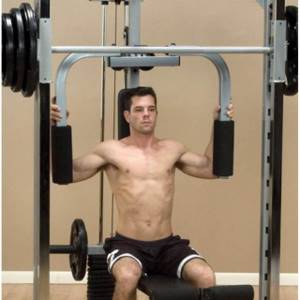
Reduction of arms in the “Butterfly” simulator
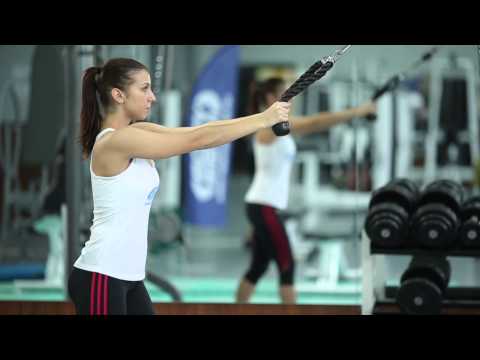
Thrust of the upper block with straight arms in a crossover
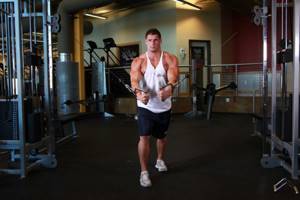
Bringing hands together in crossover
The pectoral muscles can be trained using push-ups, barbells, or machines such as:
- “Butterfly” (the most democratic exercise machine, suitable for both girls and men).
- Bringing your arms together in a crossover (guys will like it more; it looks like two cables that need to be brought together with force in front of your chest).
- Pull the upper block down with straight arms (we try to feel that it is the chest that is working, not the arms).
- All kinds of benches are assistants for working with dumbbells.
What exercise machines work your back?
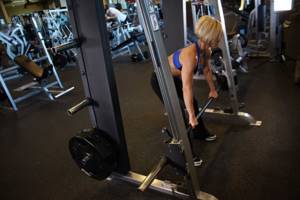
Smith machine row

Smith machine squats

Pull the lower block vertically

Raising the torso on a hyperextension bench
The back is our everything. Let's see what the weight room has in the arsenal for her.
- From experience, the most effective exercise machine for the back is a hyperextension bench (the deep layers of muscles, skeletal, are trained).
- “Smith machine” In it you can perform rows of a barbell to the waist (mainly the latissimus dorsi muscles work).
- Seated vertical block row (the name is complicated, but the exercise is easier).
- Squats with a barbell in a Smith machine (most importantly, a basic exercise for the legs and buttocks).
Which is better
For home use
Optimal model:
- medium size;
- human weight 121-150 kg;
- key fob load up to 150 kg;
- of steel;
- with additional regulators and attachments;
- allows you to perform basic exercises for the whole body.
Semi-professional exercise equipment (for the fitness room)

- multifunctional, combined fitness stations;
- maximum weight of a person – 121-200kg;
- maximum weight of additional shells – 150 kg;
- equipped with adjustable seat heights and handles.
Professional strength training equipment
- aimed at training a specific group or muscle;
- suitable for training two or more people;
- can withstand the weight of athletes heavier than 150 kg;
- additional load – more than 500 kg;
- equipped with protective attachments;
- adjustable for weight and height;
- It is possible to insert additional blocks or projectiles.
In comparison between devices with different operating principles, we can distinguish those loaded under their own and built-in weight.
Professional athletes combine all three types to achieve muscle development throughout the body, including hard-to-reach deep areas.
Hydraulic devices today have been replaced by electrically driven exercise machines, which are often used not for strength training, but for cardio training, along with exercise bikes and ellipsoids.
What exercises pump up the abs?

Raising your torso on a bench

Crossover crunches
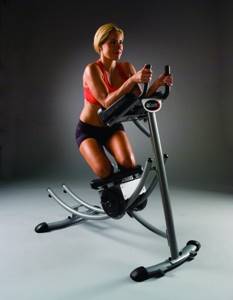
Leg pull-ups in the simulator Hanging leg raises
The “plank” exercise is ideal for general strengthening of the core. Rarely a trainer has not been tortured with the question - “What is the most effective abdominal exercise machine?” There are several simulators, all of them are associated with bending the torso forward (if conventionally, then head to hips)
- Twisting on a block (pull the upper block down, as if slouching).
- Raising the torso on a bench (like at school).
- Hanging leg raises (machine with support under the elbows).
- Pulling up legs with weights (pendulum-type exercise machine).
What exercise machines work your legs?
Calf raises with weights Leg curls in a machine Leg extensions in a machine Leg press in a machine
The legs include several muscle groups: quadriceps (front of the thigh); biceps (back of the thigh); calves (everything is clear with them) and buttocks (we will look at them separately, because the most interesting thing for all girls is to know which exercise machines to use to pump up their buttocks)
- The leg press machine trains the legs comprehensively (depending on the placement of the legs, a little emphasis can be placed)
- Leg extension in the simulator (pumps the quadriceps in isolation. We sit on a chair and simply straighten our legs)
- Leg bending in a machine (works the biceps in isolation, looks like a bench with a roller. We place the roller below the calves and bend the legs)
- We pump our calves by lifting them onto their toes with weights. (you can use a barbell on a Smith machine)
Exercise machines for gluteal muscles
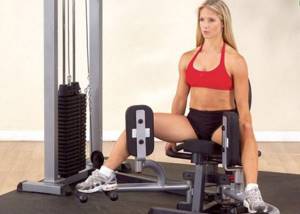
Reduction, spread of legs

Smith machine lunges
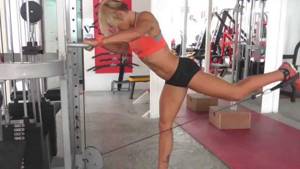
Leg abduction in crossover
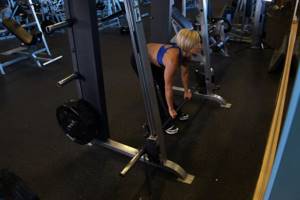
Romanian deadlift on the Smith machine
So, finally, let's look at what exercise machines pump up the buttocks. Let me remind you that the gluteal muscles are divided into large, small and medium. One lies under the other. In order to get good shape, you need to pay attention to each of them.
- Lower block row (we secure the cable of the block with a cuff on the leg, and perform back swings).
- Romanian deadlift in the Smith machine (a must for those who really want to pump up beautiful buttocks).
- Lunges with a barbell in a Smith machine (we try to squat on one leg, leaning slightly on the other).
- Lowering and spreading the legs in the simulator (we train the gluteus minimus muscles, add volume to the butt).
- Squats in a Smith machine (simpler than regular squats due to the reduced effort required to maintain balance).
In every exercise that you perform for the first time, it is important to follow the technique. If you doubt the correctness, it is better to ask a coach, a friend, or the Internet. Your health is more important than embarrassment, and besides, most athletes are kind and sympathetic people, and many will be happy to help with advice.
This concludes today’s review of the main simulators for muscle groups. We've looked at a decent list of exercises and equipment. Now you understand the purpose of most of the equipment in the gym, and you definitely won’t be bored at your next lesson in the gym.
We recommend that you familiarize yourself with the best home exercise machines for weight loss
How to choose a strength trainer
Free weights
When choosing devices under its own weight, pay attention to the following indicators:
- Permissible user weight. Give preference to models with medium or high weight (120-200 kg).
- The maximum weight of key fobs that can be used to additionally load the user during training, so as not to harm either the person or the device.
- The distance between the posts for fixation, which should be suitable for your equipment, body dimensions and room.
- The function of adjusting the height of the stands, which is necessary for safe sports activities.
- Adjustable bench angle to vary the load during exercise.
- Built-in extras include a bottle holder, towels and soft, non-slip seat and grab rails.
Loadable
When choosing equipment for a loaded workout, pay attention to the following parameters:
- Ability to adjust weight.
- Non-slip rods and handles with special relief.
- Material preference – steel.
- The ability to combine equipment with a fitness station, rack or bench.
Block simulator
Models with built-in weights are purchased for working isolated areas of the body or universal devices. When choosing, pay attention to the general indicators:
- The permissible weight of a person who exercises on the machine. Professional models are designed for 150+ kg.
- The permissible weight of equipment and key rings that can be used in the lesson without harming health and equipment.
- The build quality and material of the device, screw mechanisms and regulators.
- Built-in cables and tension regulator.
- Load correction system and the ability to repair or replace blocks.
- Built-in protective caps and regulators.
General recommendations

- Before purchasing, determine your training goal and select the right type for isolated and basic exercises.
- Pay attention to the installation location of the device and select professional or small semi-professional equipment.
- When choosing a home model, make sure that the permissible weight of the person exceeds your own by ten kilograms.
- Make a purchase only in specialized stores, order the initial debugging of the device.
Before purchasing, test the equipment for the basic exercises you intend to perform. You cannot buy a machine if it restricts movement, is too big or small, or is not adjustable.
- Pay attention to the manufacturer and place of manufacture, international quality certificates.
- Inspect the structure, spare parts, and loads. You cannot purchase a device if it is damaged or if it is not made of steel. Check the quality and strength of the cables and bearings.
- Pay attention to the set of additional equipment, what is included in it, what weights and devices you will use, and which ones are missing.
Find out whether it is possible to purchase additional missing parts and whether they are suitable for this brand and type of equipment.


